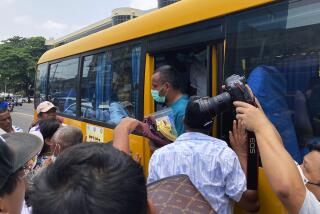Laos: a Decade of Communist Rule : Economic Woes Beset Nation Once Called a Shangri-la
- Share via
BANGKOK, Thailand — After 10 years of Communist rule, Laos remains one of the world’s poorest nations and has exchanged its former dependence on the United States for subservience to Vietnam and the Soviet Bloc.
Although the regime has claimed progress in food production, education and public health, international agencies estimate per capita income is one of the lowest in the world, at between $100 and $220.
Average life expectancy is officially said to be 45 years. There is only one doctor for every 20,000 people.
Once tied to Washington, Laos--like Cambodia--is now firmly under Vietnam’s domination, and earlier predictions that it might emerge as a neutralist “Asian Yugoslavia” have proved wrong.
The U.S. State Department estimates that Vietnam stations up to 50,000 troops in Laos, while the Soviet Union has sent in several thousand advisers.
Laos once was described as a Shangri-la, a land of mist-wreathed mountains, Buddhist temples and idyllic villages where festivals and merry-making were accorded far higher priority than work or politics.
“Not that much has changed in everyday life,” said one Bangkok-based diplomat. “The Laotians don’t like to be regimented. They don’t like political education classes and Communist seminars. There is a tremendous gap between Marxist ideology and what really goes on.”
Laos was the last of the three Indochinese nations that fell to Communist forces, lasting until December, 1975. Khmer Rouge guerrillas had entered the capital of Cambodia on April 17, 1975, and North Vietnamese tanks had rolled into Saigon, the South Vietnamese capital, on April 30 of that year.
The triumph of the Communist Pathet Lao guerrillas in Laos ended three decades of war. They were backed by the North Vietnamese, while for 20 years the United States propped up the Vientiane government with $1 billion in aid, thousands of advisers and some of the most intense air bombardments of the long Indochina conflict.
Unlike Vietnam and Cambodia, the Laotian takeover was peaceful. Communists within a coalition government ousted their “partners” within two years, a move facilitated by well-orchestrated student demonstrations and the momentum of the two earlier Communist victories.
The demonstrations in 1975 were often jovial affairs, and some Westerners described the takeover as the “song and dance revolution.”
The Communist leaders were, however, veteran revolutionaries determined to forge a new Marxist society and a “new Laotian man.”
They were led by the now 65-year-old Kaysone Phomvihan, who had joined the Communist movement in the early 1940s and whose father was Vietnamese.
Western human rights organizations soon reported that the regime had set up “re-education camps” that may have held as many as 60,000 political prisoners, one of the largest ratios of such prisoners per population in the world.
Vientiane claims the camps have been dismantled, but the London-based human rights organization Amnesty International says between 6,000 and 7,000 prisoners were still detained in early 1985. The latest U.S. State Department human rights reports say there are between 1,000 and 3,000 prisoners.
Refugees continue to flee across the Mekong River into Thailand, although in far smaller numbers.
By most accounts, insurgencies which broke out after the Pathet Lao victory have subsided. The most potent rebellion was organized by the Hmong tribesmen, many of them veterans of the “secret army” funded by the U.S. Central Intelligence Agency during the war.
Indochina observers say counterinsurgency actions, lack of support from the West and factionalism eroded the resistance, although sporadic fighting reportedly continues.
The regime’s prime battleground continues to be the economy. Emphasis is placed on agriculture, which occupies about 85% of the population.
“It’s basically a rice economy and the big question every year is how large the harvest will be,” said the Bangkok diplomat, a longtime observer of the Laotian economy.
After a nearly disastrous attempt at rapid collectivization, the government relented and allowed considerable private initiative on farms and in small businesses. Agricultural production has improved, although not enough to generate surpluses to offset other economic ills.
Thailand buys electricity from the Nam Ngum hydroelectric project, providing about 90% of Laos’ meager export earnings. With little industry, Laos depends heavily on foreign aid, receiving about $100 million each year, half of this comes from the Soviet Bloc.
The U.S. government banned aid to Laos after the Communist victory, but over the past two years relations have improved.
More to Read
Sign up for Essential California
The most important California stories and recommendations in your inbox every morning.
You may occasionally receive promotional content from the Los Angeles Times.













